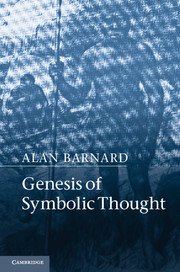2 - Stones, bones, ochre and beads
Published online by Cambridge University Press: 05 August 2012
Summary
The discipline that has had the most to say about early symbolic thought is archaeology. Yet, archaeology has no internal means of interpreting its material findings. It relies on speculation, on ethnographic comparison and on theories drawn, at least implicitly, from social anthropology. If social anthropology (or ‘sociology’, as Lévi-Strauss saw it) cannot explain the genesis of symbolic thought, then what can?
This chapter outlines recent archaeological discoveries and provides my own explanations, as well as those presented by archaeologists themselves. Important findings include etched red ochre from Blombos Cave, about 100 metres from South Africa's Indian Ocean coast, and beadwork made from shells, also found at Blombos. Both are dated to around 77,000 or 75,000 BP (see, e.g., Henshilwood 2009). There are also engraved ostrich egg shell fragments from Apollo 11 Cave in southern Namibia, dated at 83,000 BP (Miller et al. 1999). Even finds interpreted as non-Homo sapiens are possibly relevant too: for example, the Mousterian perforated cave bear femur found in Slovenia and described, controversially, as a ‘Neanderthal flute’ (see, e.g., d'Errico et al. 2003: 36–9). There are suggestions of ochre use much earlier than at Blombos, between 270,000 and 170,000 BP at Twin Rivers in Zambia (Barham 2002), possible ritual burial among Homo heidelbergensis around 320,000 BP in Spain (Bermúdez de Castro et al. 2004), and various changes in stone technology early in the African Middle Stone Age that might indicate creativity reminiscent of symbolic thought. There are even claims of ‘rock art’ that could be 290,000 or even 700,000 years old, specifically cupules at Auditorium Cave, Bhimbetka, in Madhya Pradesh, India (see, e.g., Bednarik 1996). These were discovered in the early 1990s, but beyond that not much can be said about their origins. The beautiful rock paintings found in the same area are much more recent. Robert Bednarik has published very extensively on evidence of early ‘art’ in many forms, on all inhabited continents, and broadly his conclusion (e.g., Bednarik 2003) is that Asia has the earliest of all the world's rock art and art objects. Some will differ, and for various reasons southern Africa remains the subcontinent where rock art has gained most prominence.
- Type
- Chapter
- Information
- Genesis of Symbolic Thought , pp. 15 - 39Publisher: Cambridge University PressPrint publication year: 2012



